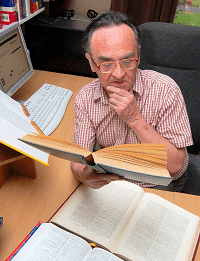About the author
After Cambridge University, where he studied physical sciences, he joined BBC radio as a studio manager. “The job was a fascinating blend of techie and creative artist,” he says. “Though at times you were dogsbody, equipment operator and referee rolled into one”. After that, he helped to start local radio in Britain, at BBC Radio Brighton, where he produced programmes about the countryside, books, consumer affairs, religion, student life and the local and general elections. He then moved to Plymouth, where he helped to start a breakfast-time two-hour sequence of news and local features.

A chance encounter with the warden of a local visitor attraction led him to make a slide-tape programme for its visitors. “I didn’t know this was new; it just seemed interesting. It was only when people began to come from all over Britain to see it, and then ask me if I could make one for them, that I realised.” For four years he ran his own business making interpretive audio-visual programmes for most national agencies in Britain and many visitor attractions.
Another chance encounter led him to his next post as curator of the Cider Museum in Hereford. He planned and developed this museum from an idea in the trustees’ minds to its opening, running research and conservation projects and raising funds by the then new way in modern Britain of a public scratchcard lottery. “One woman in a group I was lecturing to said it was bad enough to be creating a visitor attraction about alcoholic drink, without using gambling to pay for it!” He wrote two books about orcharding and cidermaking, one just called Cidermaking from Shire Publications (republished in 2009 with an updated section on changes to cidermaking practice by the big makers), the other A Drink for its Time, published by the Museum.
After that he returned to working for himself, writing scripts for exhibitions, taking on a freelance curatorial role, creating audio-visual programmes, and becoming more closely involved with planning visitor attractions. In 1986 he co-founded Touchstone Associates, a consultancy business that undertook feasibility studies, tourism planning, visitor facility planning, and the development of visitor attractions.
After illness forced him to take early retirement, he turned to his lifelong love of the English language. Yet another chance encounter led him to become a freelance reader for the Oxford English Dictionary, between 1992 and 2016 supplying more than 175,000 examples of English usage old and new. He also compiled a third of the entries for the second edition of the Oxford Dictionary of New Words. In 1996, he took advantage of spare space on his son’s website to begin posting articles on language. This soon evolved into the World Wide Words website and its associated newsletter. More than 900 issues have appeared.
Oxford University Press published his dictionary of affixes, Ologies and Isms, in 2002 (which he has now put online as a free resource). His next, Port Out, Starboard Home: And Other Language Myths, came out from Penguin Books in 2004, was serialised in the Daily Telegraph and reached the British best-seller lists; a US edition, Ballyhoo, Buckaroo, and Spuds, was published by the Smithsonian Institution Press and is in paperback from HarperCollins. In October 2006, his Gallimaufry, on words vanishing from the language, was published by Oxford University Press. His most recent book, Why is Q Always Followed by U?, a collection of some 200 questions and answers from the Q&A section of World Wide Words, came out worldwide in July 2009 from Penguin Books.
In early 2017, he ceased writing World Wide Words.
